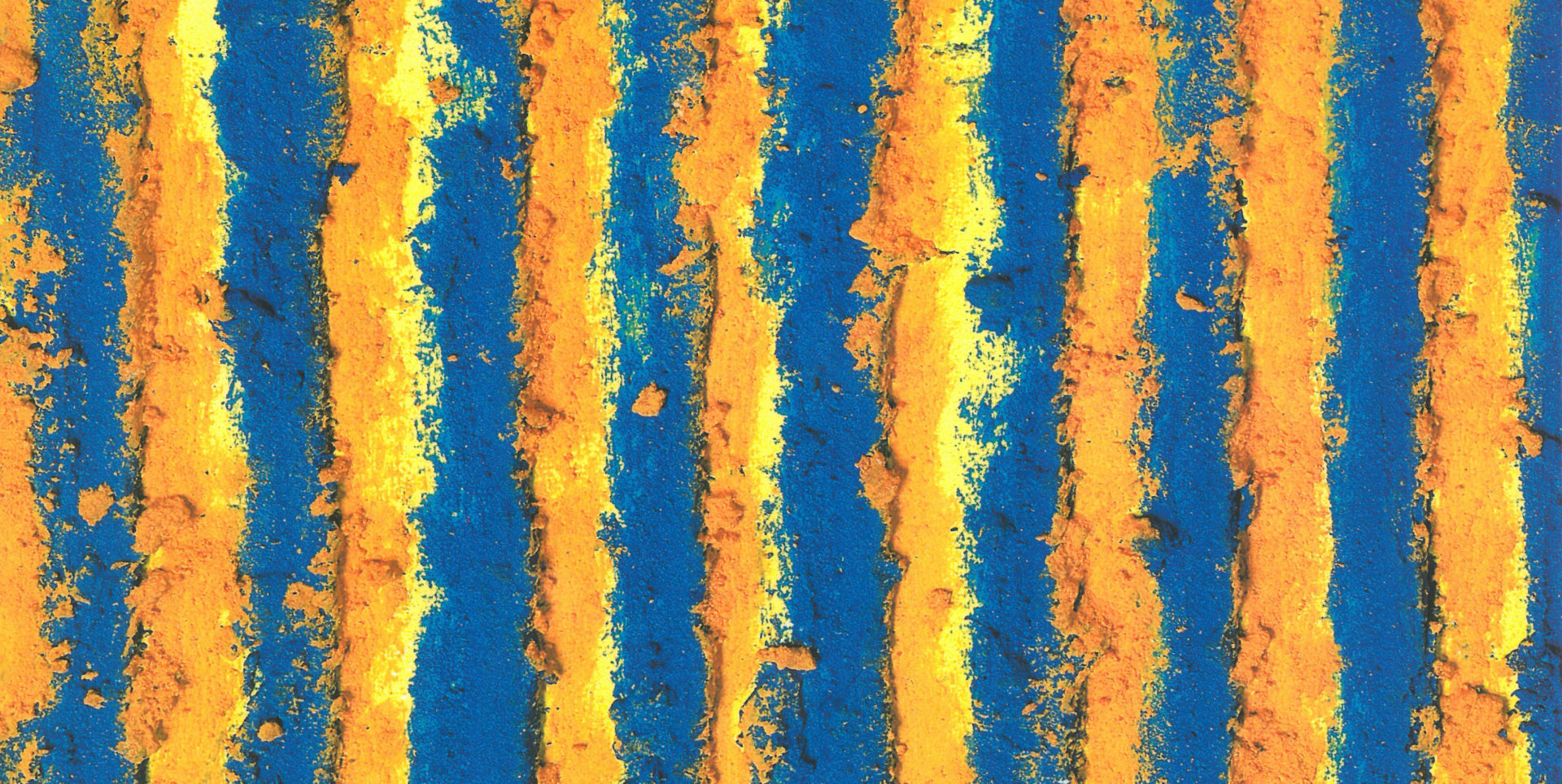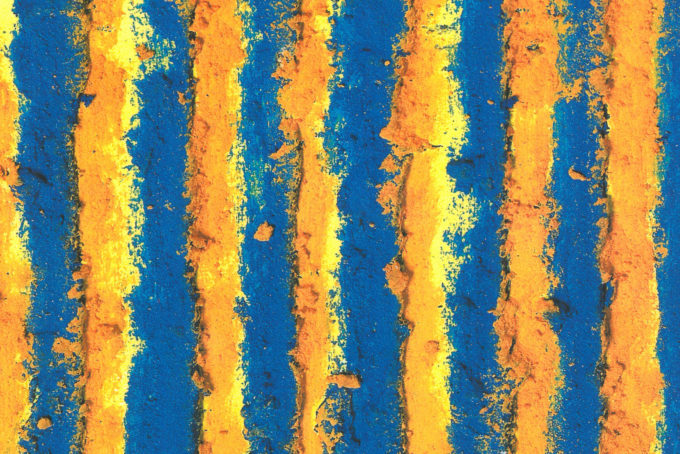
To Paint
Leon Tarasewicz
Leon Tarasewicz’s oeuvre defies description and analysis. Words and language are inadequate when it comes to rendering the alien world of painting whose subject is painting, painting devoid of narrative, though not detached from reality.
Tarasewicz’s painting springs from observation of the landscape, it is a tribute paid to nature in its most essential and fundamental aspects. It is imitation, tender and humble. The origins of this painting are also to be found in art, in painting itself, which Tarasewicz sees as something no less remarkable than nature. With the help of colour, texture, light and rhythm, applied to the flat surface of the canvas or paper, the artist creates new worlds, as real and beautiful as the one we Iive in. Tarasewicz’s painting is an act of creation, it is almost insolent in its magnificence.
“To paint” seems to be a calling for Tarasewicz. His inherent need to paint is exceptionally strong. Painting is the language he uses to speak about the world and to express himself. Painting is his element, combining play and ritual: a never-ending experimentation with colour, rhythm, form and ground. His paintings radiate the joy of creation, the carefree combination of colours, but also an almost religious solemnity in the face of art. Painting is his creed and his refuge, a joy and a burden which can never be shrugged off.
At first the shapes in Tarasewicz’s paintings were recognisable at a glance. Among his favourite motifs were tree-trunks, birds in flight, furrows ploughed in the soil. In time, these often recurring themes came to be treated more summarily, freely, sensuously until their seemingly complete evanescence in abstraction.
Tarasewicz’s understanding of painting also came to be more encompassing. While he had always been enamoured of large formats, be it oil on canvas or gouache on paper, by the mid-1980s such media proved insufficient. His painting sought to burst out into space. The artist once wrote: “the dream is for the painting to take possession of the viewer in such a way that his surroundings would cease to exist and the painting, unconstrained by any frame, could freely expand and draw one in.” This attitude led Tarasewicz to make his monumental paintings directly on gallery walls, in purpose-built tunnels and mazes and on the floor. Viewers are confronted with a painting spanning “as far as the eye can see,” “all the way to the horizon,” one could almost say. As a result, the boundary between nature and painting, between the represented and the representer, between, reality and painterly illusion is blurred even further. The painting seems to be something “of this world.” Surrounded by painting on all sides of the gallery, wandering amidst the rectangular pillars steeped in colour, we truly feel its physical presence.
This painting addresses reality on many levels. It encompasses the local colour of the monotonous, flat and vast Polish landscapes amidst which the artist grew up and lives, as well as the constitutive and universal traits of nature as such: the alternation of mutability and constancy, necessity and chance, repetitive rhythms and the continuity of the horizon. Tarasewicz’s paintings should be seen in the context of the Old Masters and of the Polish schools of Colourism and Unism.
Fidelity to painting, the courage needed to use its traditional idiom is for Tarasewicz not rooted in denial or rejection of new media, it is not “going against the grain,” but the natural consequence of following the inner categorical imperative that requires him “to paint!”
- YEAR2001
- CATEGORY Biennale Arte
- EDITION49
- DATES10.06 – 04.11
- COMMISSIONERAnda Rottenberg
- CURATORAneta Prasał-Wiśniewska
Fragments of Jan Gryka's essay
The vision created painstakingly by Leon Tarasewicz and incarnated in a picture consists of exactly what Painting itself consists of in its essence. On the other hand, Tarasewicz s individual style, his way of revealing in a painting what is hidden and was invisible before, and finally introducing the new into painting, are the result of the freshness of pictorial visualization of emotions and sensations in relation to places and landscapes. (…)
His own creative decisions, bought at the price of hesitation and criticism of “current trends” in art, endow Tarasewicz’s paintings with a quality of objectivity which locates the fruits of his individual creative undertakings in the world of supra-individual Painting.
Jaromir Jedliński, Naprzeciw pejzaży [Facing Landscapes], fragment, in Leon Tarasewicz (catalogue), Galeria Krzysztofory, Kraków 1990
The 49th Biennial of Visual Arts in Venice is the first one in the new millennium. It opens a new era and not only because the arithmetic of time dictates it. New times are taking shape in front of our eyes, but they also include the whole heritage of the previous thousand years, both in a positive and a negative sense. There is no gauge to measure growth and decline, and participating in the development of civilisation brings about the kind of entanglements Nobel faced when he invented dynamite. It is impossible to choose only the positive dimension of contradictory civilizational change; but it is up to us which part of it we choose to take part in and what outcome we hope to achieve.
Harald Szeemann, the general commissary of the 2001 Biennial, suggests in his programme statement that we “need to look back to the values which have retained their importance after the second revolution in the visual arts”1, and a general aim of the Biennial is to meet on a “platform of humanism”. Guided by similar motives Aneta Prasał-Wiśniewska suggested Leon Tarasewicz as the author of the display in the Polish Pavilion, justifying the choice by a reference to absolute values and asking: “lsn’t painting as such, as a medium, as a method of describing the world, one of those values? (…) We can still imagine the world without installations, without video art, with some effort – without photography, but it is impossible to imagine a world without painting. Older than history and philosophy, older than the concept of art, painting enabled the first artists, who were as yet unaware of being artists, to describe the world and to express emotions.”2
One can’t imagine Polish art in the last twenty years or so without Leon Tarasewicz’s painting. It is a point of reference giving meaning to that art, both in terms of individual exploration and as part of a line of development from Constructivism and Unism thorough Colourism to abstraction. Tarasewicz summarizes these historical experiences in his art, setting rules for his own work and his identity, which combine many cultural threads, finally blending into a whole. This identity is encoded in the language of paintings, which are a universal form, comprehensible both in their place of origin and in any other place where notions of art exist. Transporting the values developed by the artist to such a culture -saturated place as Venice seems a good way to give these explorations a more universal dimension. Venice, traditionally linking painting and architecture, and calling to mind great artists from the past, whose art is not only connected with the history of the city, but who created some of the greatest values in the history of mankind, offers every artist a unique opportunity to test himself. It most certainly makes for a meeting on the “platform of humanism”, almost renaissance in scope.
The original project submitted by Leon Tarasewicz for the Venice Biennial was meant to be a conscious intervention in the city’s historic public buildings. It was an attempt at dialogue with the existing architectural forms:
St. Mark’s Column (12th c.) is covered with yellow and green striped cloth, The same colours appear on the colonnade of the Procurazie Vecchie and a few select gondola landings, around which gondola’s cruise. These places, laden with symbolism, would create a dialogue between the city’s history, which goes back to the Middle Ages, and these signs of an industrial origin – abstract, horizontal yellow and green stripes. These projects were to be linked, through a network of informational situations proper to the era of multimedia, to the Polish Pavilion and at the same time to the living tissue of the contemporary city. The aim of the project was to be revealed in public space on a total scale that it would be impossible to overlook. Using the methods of advertising, Tarasewicz wanted to give a bit of himself to the thousands of people who would be visiting Venice at the time. This step might result in an exchange of thought, both in an existential and an artistic sense. The project, which turned out to be unfeasible, will probably remain in the sphere of ideas, a testimony to the possibility of renewing the ties between painting, on the one hand, and history and modern civilization, on the other.
The project which will actually be realized in Venice gives some idea of Tarasewicz’s art while remaining in touch with the place where it is to be executed. The “floor” painting in the Polish pavilion will be an emanation of subtle concepts, of a search for themes concealed within the identity of place and time. In order to understand the path leading up to this point, we need to go back in time and briefly look at everything Tarasewicz has encompassed in his painting since he graduated from the Academy of Fine Arts in 1984.
1 quated after: Aneta Prasał, desription of Leon Tarasewicz’s project for the 49th Venice Biennale
2 ibid.

